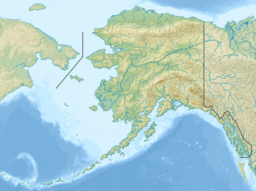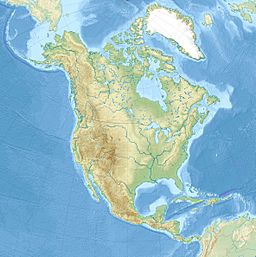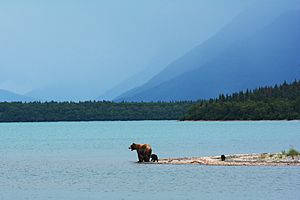Naknek Lake facts for kids
Quick facts for kids Naknek Lake |
|
|---|---|
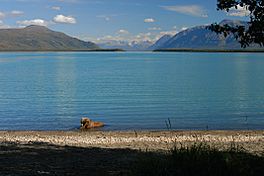
A grizzly bear in Naknek Lake, with Iliuk Moraine and Iliuk Arm Naknek Lake in the background
|
|
| Location | Lake and Peninsula Borough and Bristol Bay Borough, Alaska |
| Coordinates | 58°38′11″N 155°56′27″W / 58.63639°N 155.94083°W |
| Primary outflows | Naknek River |
| Basin countries | United States |
| Max. length | 64 km (40 mi) |
| Max. width | 13 km (8.1 mi) |
| Surface area | 150,000 acres (61,000 ha) |
Naknek Lake is a large lake in southern Alaska. It is located at the base of the Alaska Peninsula. This beautiful lake is part of Katmai National Park and Preserve.
Naknek Lake is about 64 kilometers (40 miles) long. It is also between 5 to 13 kilometers (3 to 8 miles) wide. This makes it the biggest lake in the park! The lake's water flows west into Bristol Bay through the Naknek River. Over thousands of years, the lake's water level has slowly dropped. This happened as the river cut through a glacial moraine, which is a pile of rocks and dirt left by a glacier. This process also created Brooks Falls about 3,500 years ago.
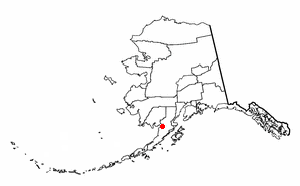
The name Naknek was first reported by an early Russian explorer. Another explorer later called it "Akulogak." An American named Ivan Petrof later named it Lake Walker. He did this to honor Francis Amasa Walker, who was in charge of the 1880 United States census.
Fishing Fun at Naknek Lake
Naknek Lake is very famous for sport fishing. Many people come here to catch fish. It is home to one of the biggest populations of king salmon in southwestern Alaska.
However, there are even more sockeye salmon here. You can also find pink and chum salmon. Large rainbow trout are common in the lake too. Other fish you might find include northern pike, lake trout, and Arctic char.
Brooks Camp is a popular spot on the lake's shore. It is where the Brooks River flows into the lake over some rapids.
Amazing Animals of Naknek Lake
Naknek Lake is full of different kinds of animals. These animals are typical of the Alaska Peninsula.
You can often see moose and wolves around the lake. Sometimes, you might even spot wolverines. But the lake is most famous for its sockeye salmon and grizzly bears.
The grizzly bears are a huge attraction here. They are often seen walking around the lake. They also wade into the water to catch fish. The most bears are found at Brooks Camp. Bears are frequently seen at Brooks Falls. They gather there to catch salmon as they jump up the falls. Watching these bears is a main reason why people visit Naknek Lake and Brooks Falls.


